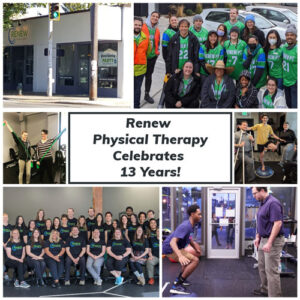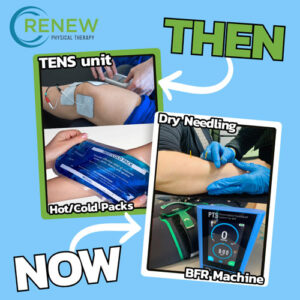
Physical therapy is often viewed through the lens of movement—restoring strength, improving mobility, and alleviating pain. But ask any experienced physical therapist, and they’ll tell you that healing isn’t just physical. At Renew Physical Therapy, our therapists have seen firsthand how mental health, the power of movement, and even navigating complex healthcare systems can shape a patient’s recovery just as much as their physical condition.
When Pain Is More Than Just Physical
One Renew physical therapist recalls a patient whose chronic pain had been misattributed solely to structural issues.
“It was clear from the first few sessions that their mental health played a huge role in their pain,” the physical therapist explained.
Rather than forcing a conventional treatment plan, they worked together to adapt sessions to the patient’s emotional state. Some days, physical therapy meant working in a dimly lit room, focusing on breathwork and slow, mindful movement. Other days, when the patient felt more at ease, they’d shift to engaging sessions in the gym, using conversation as a way to ease tension and build confidence in movement. Over time, these tailored approaches helped the patient feel safe in their body again—something that no single exercise or manual technique alone could achieve.
Long-Term Wellness and Health Management
Another Renew physical therapist recalls working with a patient who came to physical therapy hoping to manage their chronic knee pain but shared a deeper goal—getting back to the active lifestyle they once loved.
They had once taken pride in their fitness, but over the years, life had gotten in the way, and movement had become more painful and difficult. Determined to regain their strength, they dedicated over a year to consistent physical therapy sessions, gradually rebuilding their confidence, endurance, and ability to exercise without fear.
“It wasn’t just about fixing the knee,” the physical therapist explained. “It was about helping them reconnect with movement in a way that felt good and sustainable.”
Over time, the patient not only reduced their knee pain and returned to regular exercise, but they also achieved an unexpected bonus—lowering their blood pressure enough to reduce their medication. Looking back, they credited physical therapy not just with helping them move again, but with giving them the foundation to reclaim the healthy, active life they had once enjoyed.
Physical Therapists as Patient Advocates
The role of physical therapy often extends beyond the treatment table. Many therapists across Renew have stepped up as advocates for their patients, ensuring they receive the care and resources they need. Whether it’s writing letters to physicians, setting up case meetings with other providers, or helping injured workers navigate the complexities of the LNI system, physical therapists are often the bridge between a patient and their recovery.
“One of our biggest responsibilities is making sure our patients aren’t just left to figure things out on their own,” a physical therapist explained. “Whether it’s getting an injured worker access to the right equipment or pushing for additional care, we’re in their corner.”
A Holistic Approach to Healing
These stories are a reminder that physical therapy is so much more than just treating muscles and joints. A holistic approach—one that considers mental health, pain perception, and advocacy—can make all the difference. At Renew Physical Therapy, we know that sometimes, the most important thing we can do for our patients isn’t just strengthening a limb, but strengthening their trust in movement, their healthcare, and themselves.







